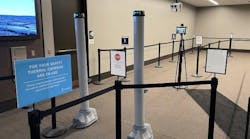NEVADA TEST SITE, Nev. - The scientists stood waiting for a read-out from a hand-held Geiger counter-type machine placed next to a large corrugated metal shipping container. During the test at the Radiological-Nuclear Countermeasures Test and Evaluation Complex in the Nevada desert, the equipment failed to identify the plutonium in the container. On a second try, it worked.
Beyond the checkpoints, fences and armed guards, Homeland Security scientists here are working on a $33 million program to perfect devices that can more accurately detect nuclear devices and "dirty bombs."
"If we're not going forward with an investment in this type of technology, we could very easily miss an opportunity to defeat a terrorist with a dirty bomb or a radiological device," said Rep. Jim Gibbons, a member of the House Subcommittee on Prevention of Nuclear and Biological Attacks, who recently toured the site.
The program, a division of the federal Homeland Security Department, was created under a presidential order to refine methods to protect the nation from radiological and nuclear threats.
The test site is a stone's throw from an ultra-secure bunker in the desert, where the nation's nuclear weapons are assembled. It is surrounded by barren mountains, spiky yucca trees and craters left from decades of nuclear weapons tests about 75 miles north of Las Vegas.
The place provides an opportunity for scientists to test for nuclear material, including weapons-grade plutonium, in secure and controlled conditions.
Some of the monitors now used to identify such material do not always work, said Vayl Oxford, director of the federal Domestic Nuclear Detection Office.
The test site, a vast federal reservation the size of Rhode Island, also hosts the National Center for Combating Terrorism, which includes several facilities to improve the nation's ability to prevent or recover from a terrorist attack.
Technicians are testing pillar-style roadside sensors like those deployed to ports of entry and some highway weigh stations. The sensors detect neutrons and gamma rays emitted by lethal nuclear devices or radioactive isotopes that could be dispersed by less sophisticated explosives in a "dirty bomb."
The scientists also are testing sensors in vehicles, including white ambulance-style vans, black SUVs and a Jeep loaded with sophisticated radiation sniffers and computers.
The tests aim to see whether the 30 or so devices available commercially can distinguish a bomb from less harmful sources of radioactivity, such as a person who has had a radioactive isotope injected during a medical procedure, or household items like kitty litter and floor tiles that contain natural trace amounts.
"We get alarms frequently with medical patients or other materials," Oxford said.
Of the 10,000 alarms tallied to date across the nation, all have been resolved by closer inspections and matching shipments to manifests.
Detecting radioactive materials in public places is an evolving science, Oxford said. There are no national standards for devices that range from the size of a steam iron to the two-door prototype "Smart Jeep."
The next generation of hand-held detectors should be able to identify radiation sources without the need to open shipping containers using what Oxford calls "discrimination capability."
One goal will be to publish what officials say should be a "Consumer Reports"-style guide with information that state and local police, fire and security officials can use before buying the machines.
After nine months of testing, and with federal budgets being drawn up, program officials spent the week conducting tours for congressional representatives, reporters and first responders learning how to use the devices.
Gibbons, R-Nev., toured the site, which is in his home district, along with subcommittee Chairman James Langevin, D-R.I., Rep. John Linder, R-Ga., and Rep. Charles Dent, R-Pa., members of the House Homeland Security Committee.
"Of all the concerns we have for our nation's security, the most serious is the threat of nuclear or biological attack," Dent said in a statement. "I wanted to take the opportunity to see this front of the War on Terror."
___
On the Net:
Nevada Test Site, Radiological/Nuclear Countermeasures Test and Evaluation Complex: http://www.nv.doe.gov/nationalsecurity/homelandsecurity/radnuc.htm
[AP Online -- 01/30/06]

